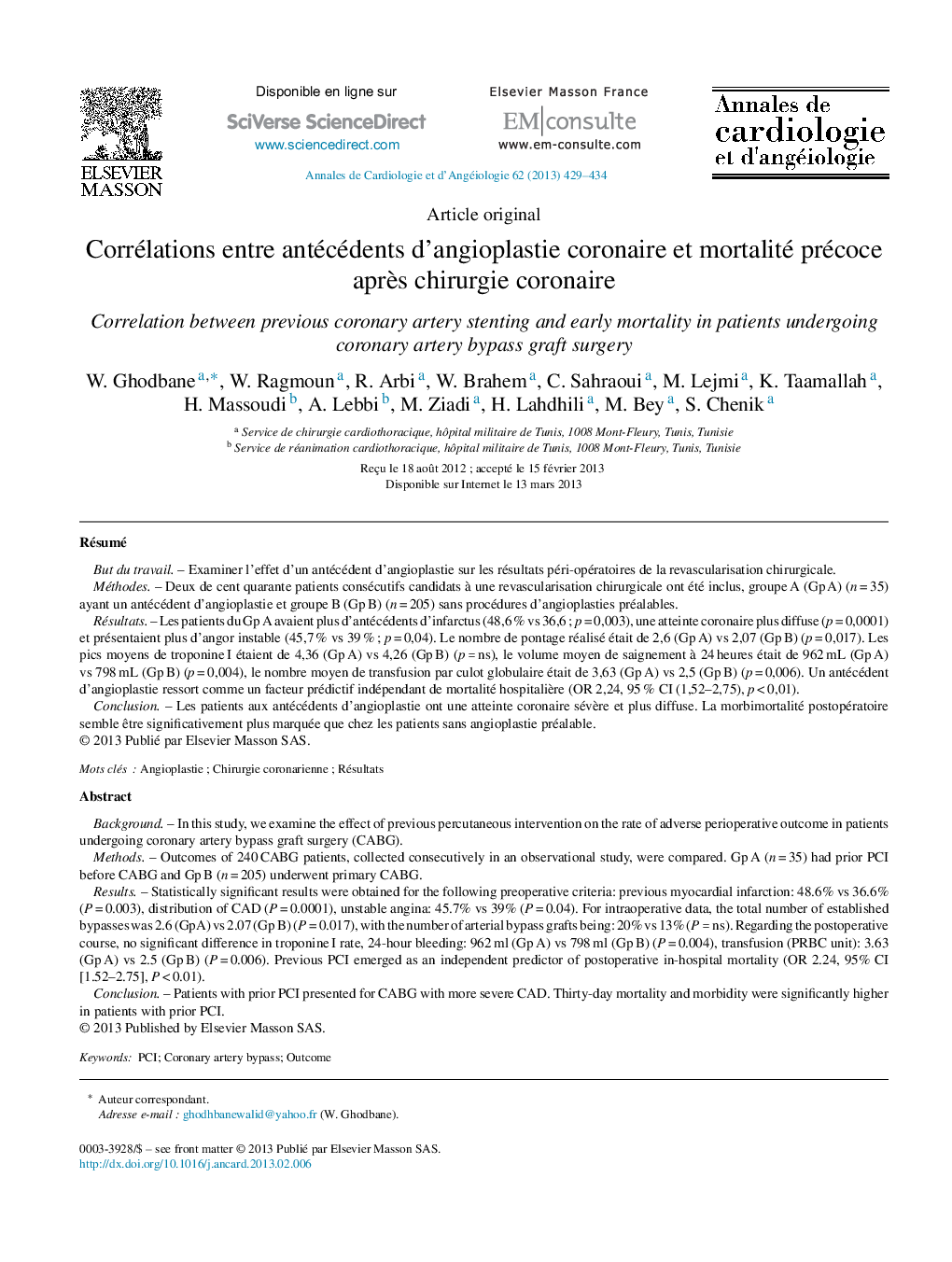| Article ID | Journal | Published Year | Pages | File Type |
|---|---|---|---|---|
| 2868981 | Annales de Cardiologie et d'Angéiologie | 2013 | 6 Pages |
RésuméBut du travailExaminer l’effet d’un antécédent d’angioplastie sur les résultats péri-opératoires de la revascularisation chirurgicale.MéthodesDeux de cent quarante patients consécutifs candidats à une revascularisation chirurgicale ont été inclus, groupe A (Gp A) (n = 35) ayant un antécédent d’angioplastie et groupe B (Gp B) (n = 205) sans procédures d’angioplasties préalables.RésultatsLes patients du Gp A avaient plus d’antécédents d’infarctus (48,6 % vs 36,6 ; p = 0,003), une atteinte coronaire plus diffuse (p = 0,0001) et présentaient plus d’angor instable (45,7 % vs 39 % ; p = 0,04). Le nombre de pontage réalisé était de 2,6 (Gp A) vs 2,07 (Gp B) (p = 0,017). Les pics moyens de troponine I étaient de 4,36 (Gp A) vs 4,26 (Gp B) (p = ns), le volume moyen de saignement à 24 heures était de 962 mL (Gp A) vs 798 mL (Gp B) (p = 0,004), le nombre moyen de transfusion par culot globulaire était de 3,63 (Gp A) vs 2,5 (Gp B) (p = 0,006). Un antécédent d’angioplastie ressort comme un facteur prédictif indépendant de mortalité hospitalière (OR 2,24, 95 % CI (1,52–2,75), p < 0,01).ConclusionLes patients aux antécédents d’angioplastie ont une atteinte coronaire sévère et plus diffuse. La morbimortalité postopératoire semble être significativement plus marquée que chez les patients sans angioplastie préalable.
BackgroundIn this study, we examine the effect of previous percutaneous intervention on the rate of adverse perioperative outcome in patients undergoing coronary artery bypass graft surgery (CABG).MethodsOutcomes of 240 CABG patients, collected consecutively in an observational study, were compared. Gp A (n = 35) had prior PCI before CABG and Gp B (n = 205) underwent primary CABG.ResultsStatistically significant results were obtained for the following preoperative criteria: previous myocardial infarction: 48.6% vs 36.6% (P = 0.003), distribution of CAD (P = 0.0001), unstable angina: 45.7% vs 39% (P = 0.04). For intraoperative data, the total number of established bypasses was 2.6 (GpA) vs 2.07 (Gp B) (P = 0.017), with the number of arterial bypass grafts being: 20% vs 13% (P = ns). Regarding the postoperative course, no significant difference in troponine I rate, 24-hour bleeding: 962 ml (Gp A) vs 798 ml (Gp B) (P = 0.004), transfusion (PRBC unit): 3.63 (Gp A) vs 2.5 (Gp B) (P = 0.006). Previous PCI emerged as an independent predictor of postoperative in-hospital mortality (OR 2.24, 95% CI [1.52–2.75], P < 0.01).ConclusionPatients with prior PCI presented for CABG with more severe CAD. Thirty-day mortality and morbidity were significantly higher in patients with prior PCI.
